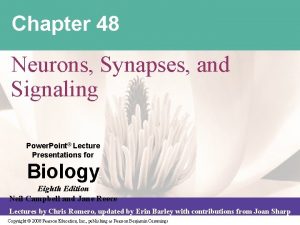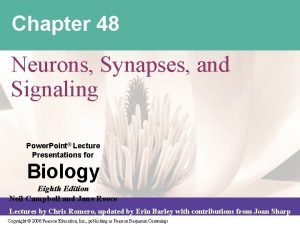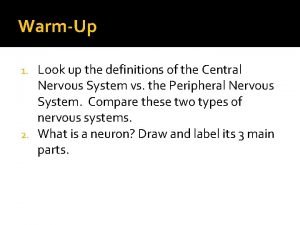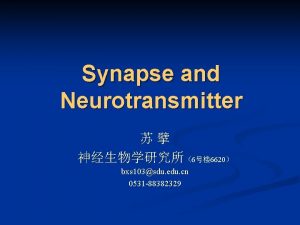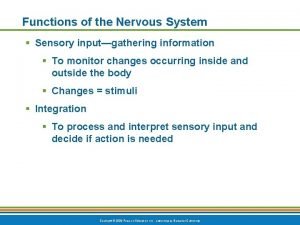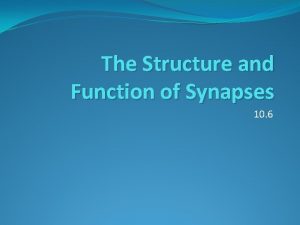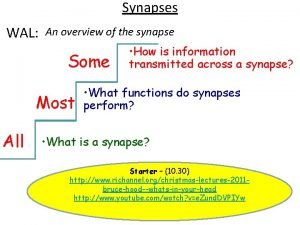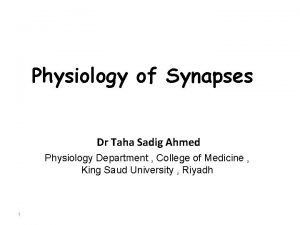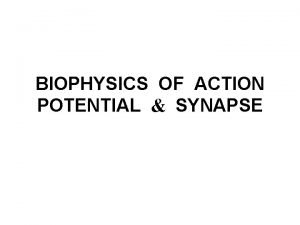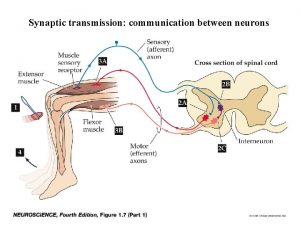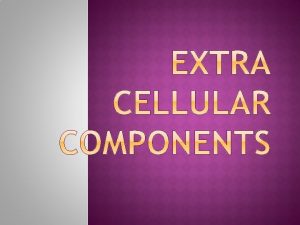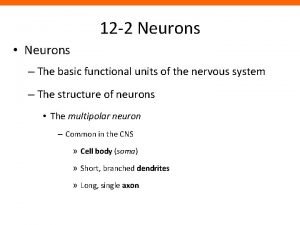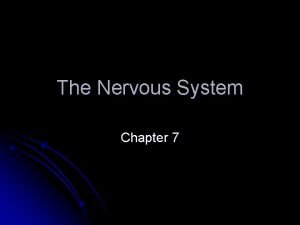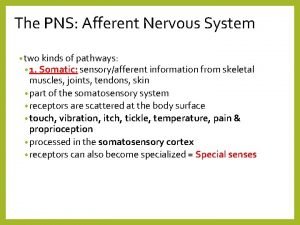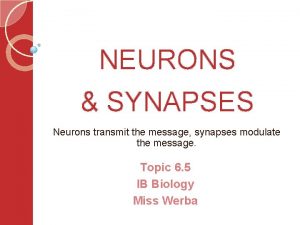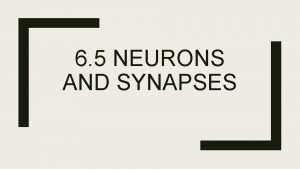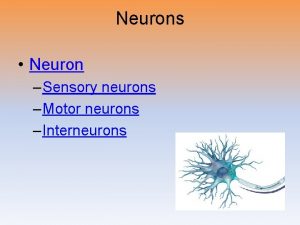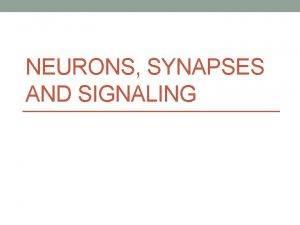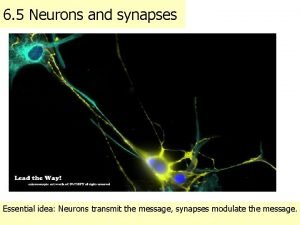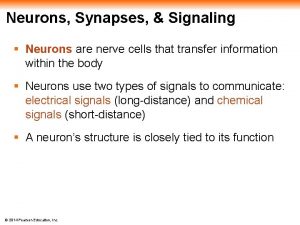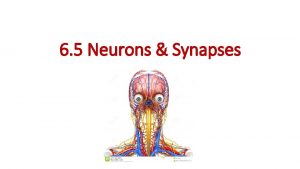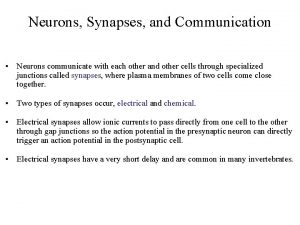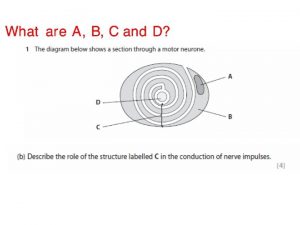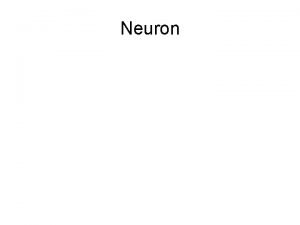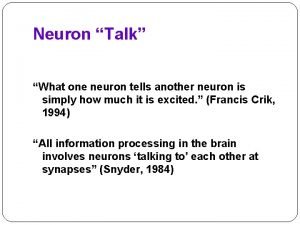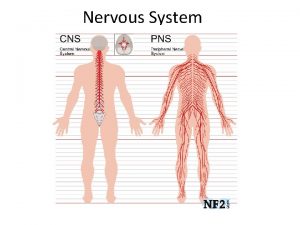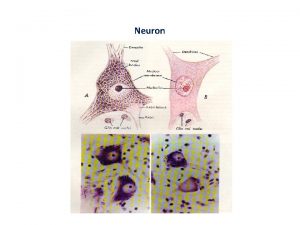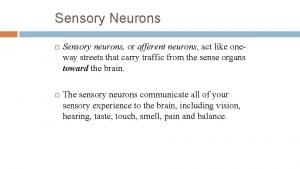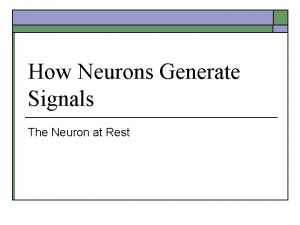Neurons Signals Synapses Chapter 37 I Neuron Structure






















- Slides: 22

Neurons, Signals, Synapses Chapter 37

I. Neuron Structure Dendrites • Dendrites receive signals from other neurons • Cell body contains Cell body nucleus and organelles Axon • Axon transmits signals to other neurons or muscles Fig. 37. 5 Motor neuron

Presynaptic neuron Figure 37. 2 Stimulus Cell body Axon Synapse Synaptic terminals Postsynaptic neuron Neurotransmitter

• Synapse – junction of a nerve cell with another cell • Relative terms depending on cell location in network: – Pre-synaptic cell – cell sending signal across synapse – Post-synaptic cell – cell receiving signal

Figure 37. 3 80 m Real neurons Green = dendrites Cyan = neuron cell bodies Red = support cells (glia) Cell bodies of neurons

II. Resting potential • Bioflix: How Neurons Work

II. Resting potential • Resting potential = charge difference across a cell membrane of ALL Body Cells • Develops because of Na+ & K+ movement • Ion movement through 3 membrane proteins: – Na+-K+ pump – Passive K+ channels – Passive Na+ channels

Figure 37. 6 Key Na K Sodiumpotassium pump Potassium channel OUTSIDE OF CELL Sodium channel INSIDE OF CELL


Description of ion movement • Na+-K+ pump: pumps 3 Na+ out & 2 K+ in to the cell • Result: – [Na+] = 15 m. M inside – [K+] = 140 m. M inside 150 m. M outside 5 m. M outside

• Passive K+ channel: always open – K+ leaves cell – Cl- and Protein- are stuck inside cell • Result: – (-) charge now greater inside cell – (-) charge attracts (+) charge on outside, electrical gradient limits K+ efflux (outflow)

III. Action potential • Bioflix: Action Potential

III. Action Potential • Depends on voltage-gated Na+ & K+ channels – Passive channels that are closed at rest – Open in response to a change in voltage across cell membrane – Like an electrically operated gate

Description of ion movement • Stimulus changes membrane potential (voltage) • If change is large enough that voltage exceeds a threshold, voltage-gated Na+ channels open • Na+ flows into cell • Change in potential CLOSES voltage-gated Na+ channels and OPENS voltage-gated K+ channels • K+ leaves cell

• Na+-K+ pump re-establishes gradients of Na+ and K+ • Action potential spreads because Na+ diffuses along the inside of the cell membrane, changing voltage & opening the next batch of voltagegated Na+ channels

Figure 37. 11 Key Na K 50 Membrane potential (m. V) 3 Rising phase of the action potential OUTSIDE OF CELL 100 Sodium channel Potassium channel Action potential 3 0 50 2 Depolarization 4 Falling phase of the action potential Threshold 2 1 4 5 Resting potential Time INSIDE OF CELL Inactivation loop 1 Resting state 5 Undershoot 1

IV. Synapse • Bioflix: How Synapses Work

A real synapse Synaptic terminals of pre-synaptic neurons 5 m Postsynaptic neuron Figure 37. 16

Figure 37. 15 Presynaptic cell Postsynaptic cell Axon Synaptic vesicle containing neurotransmitter 1 Postsynaptic membrane Synaptic cleft Presynaptic membrane 3 K Ca 2 2 Voltage-gated Ca 2 channel Ligand-gated ion channels 4 Na

At chemical synapse • Electrical signal crosses the synaptic cleft = gap between neurons • How? – A. p. reaches end of neuron – Voltage changes in the neuron membrane – Voltage-gated Ca 2+ channels open – Ca 2+ binds to vesicles containing neurotransmitter – Vesicles fuse with neuron membrane

(continued) – Neurotransmitter is released by exocytosis into the synaptic cleft – Neurotransmitter binds to receptors on next neuron – Receptors are ligand-gated Na+ channels = Na+ channels that open when the right molecule (ligand) attaches – Neurotransmitter detaches from receptors and is degraded by enzymes to stop signal

What happens next? • The postsynaptic cell responds if the postsymatic potential reaches threshold • Postsynaptic cells could be : – Nerve cells – Muscle cells – Glandular cells
 Chapter 48 neurons synapses and signaling
Chapter 48 neurons synapses and signaling Chapter 48 neurons synapses and signaling
Chapter 48 neurons synapses and signaling Bioflix activity: how synapses work -- synapse structure
Bioflix activity: how synapses work -- synapse structure Communicative signals and informative signals
Communicative signals and informative signals Difference between communicative and informative signals
Difference between communicative and informative signals Communicative and informative signals
Communicative and informative signals 2 types of synapses
2 types of synapses How is one-way conduction at synapses ensured
How is one-way conduction at synapses ensured Functions of the synapse
Functions of the synapse Synapses telecom
Synapses telecom Functions of synapses
Functions of synapses Synapse
Synapse What are electrical synapses
What are electrical synapses Chemical synapses
Chemical synapses Part of nervous system
Part of nervous system Layers of cell wall
Layers of cell wall Anaxonic neuron structure
Anaxonic neuron structure Structure of neuron ppt
Structure of neuron ppt Neuron structure
Neuron structure Virtual neurons
Virtual neurons First second and third order neurons
First second and third order neurons Brain homunculus
Brain homunculus Via optica
Via optica
